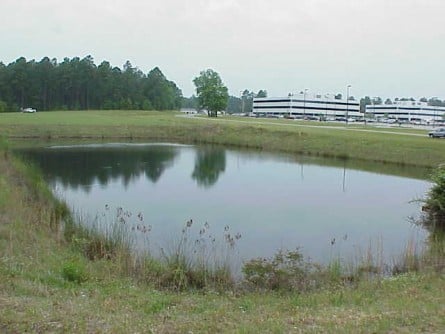Retention Ponds May Not be Retaining Much | Engineering360
Published on by Naizam (Nai) Jaffer, Municipal Operations Manager (Water, Wastewater, Stormwater, Roads, & Parks)
 Because it is inexpensive and works effectively at lower temperatures, road salt (sodium chloride) is widely used by most municipalities to keep winter roadways clear.
Because it is inexpensive and works effectively at lower temperatures, road salt (sodium chloride) is widely used by most municipalities to keep winter roadways clear.
However, researchers at Virginia Tech and Towson University in Maryland believe that the chemicals used to treat winter roadways are reaching waterways instead of being absorbed by plants and soil as intended.
Retention ponds are meant to trap water runoff from roads and parking lots — preventing pollutants from reaching surface waters. The ponds are designed to prevent flooding, to increase water absorption in the soil and to encourage algae and plants to absorb pollutants before reaching streams and wetlands where they might otherwise harm humans and wildlife.
“We know that surface waters in many areas are becoming more saline and that salt levels have been rising steadily for at least the past 30 years in reservoirs that provide water for Baltimore,” said Joel Snodgrass, professor and head of the Department of Fish and Wildlife Conservation in Virginia Tech’s College of Natural Resources and Environment. “However, we know little about the effectiveness of stormwater management practices in reducing inputs of salt to surface waters.”
Testing water samples collected from stormwater ponds in Baltimore County and the county’s Red Run Watershed to compare sodium and chloride ion concentrations in the groundwater between stormwater ponds and streams, researchers found that pond water soaked into the ground and traveled down-hill toward streams. If the ponds had been working appropriately, the groundwater between streams and ponds would return very low levels of sodium chloride because they were successfully retained by the pond.
Instead, researchers found that the groundwater running from ponds to streams was highly contaminated with the road salt.
“Current stormwater management practices may help slow the movement of road salts to streams, but they don’t completely stop it from getting there,” Snodgrass explained. “On top of that, the road salts are entering these bodies of water in a fashion that causes salt levels in streams to remain elevated year-round.”
Higher levels of salt in groundwater and surface waters can negatively impact both humans and wildlife. In freshwater areas with increasing salt levels, fish and amphibians may stop breeding and eventually die out because they can’t adapt to the change.
“You’re basically putting these animals in a desert, because they can’t regulate the salt in their bodies and get enough water to balance it out,” Snodgrass said.
For humans, added salt to water systems can affect both the color and taste of the water, eventually causing the wells to stop producing potable water.
“People may end up drinking water containing sodium levels that exceed those recommended for people on low-sodium diets. Municipal water supplies may also become contaminated and require treatment to lower sodium and chloride levels before distribution,” Snodgrass said.
Although there is no immediate solution to the issue, researchers plan to analyze the costs and benefits associated with using road salts, including continued research about how road salts and other chemicals affect wildlife and the environment. Other researchers are exploring alternatives to road salts and their potential effects on the environment and human health.
“It’s a balance sheet we’re looking at between economics and the environment and human health,” Snodgrass said. “This is a complex problem that’s going to take an interdisciplinary team to tackle, including sociologists, economists and chemists, as well as biologists and ecologists.”
The study is published in Environmental Science and Technology .
Attached link
http://insights.globalspec.com/article/5335/retention-ponds-may-not-be-retaining-muchTaxonomy
- Stormwater Management
- Stormwater
- Storm Water Management
- Stormwater Runoff